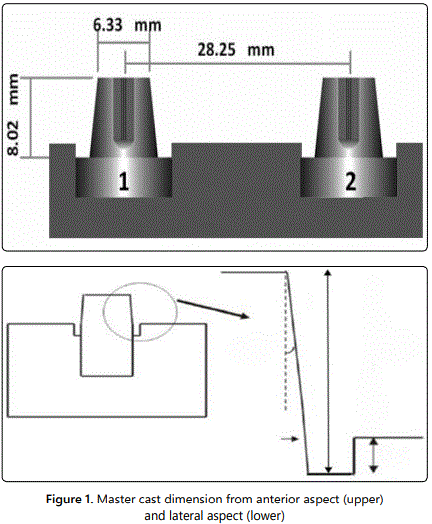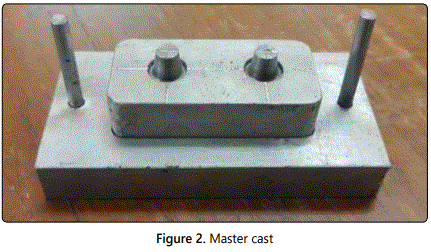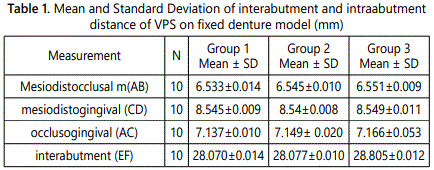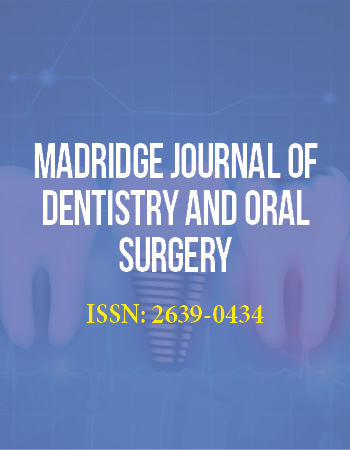Research Article
Impact of Chitosan as Disinfectant to the Dimensional Accuracy of Vinyl Polisiloxane Elastomeric Impression Material
Department of Prosthodontics, Faculty of Dentistry, Gadjah Mada University, Yogyakarta, Indonesia
*Corresponding author: Haryo M Dipoyono, Department of Prosthodontics, Faculty of Dentistry, Gadjah Mada University, Yogyakarta, Indonesia, E-mail: dipoyono@yahoo.com
Received: September 30, 2016 Accepted: November 30, 2016 Published: March 8, 2017
Citation: Ismiyati T, Dipoyono MH. Impact of Chitosan as Disinfectant to the Dimensional Accuracy of Vinyl Polisiloxane Elastomeric Impression Material. Madridge J Dent Oral Surg. 2017; 2(1): 41-43. doi: 10.18689/mjdl-1000110
Copyright: © 2017 The Author(s). This work is licensed under a Creative Commons Attribution 4.0 International License, which permits unrestricted use, distribution, and reproduction in any medium, provided the original work is properly cited.
Abstract
Vinyl polysiloxane (VPS) is one of elastomeric impression material used in dentistry. In impression making, dentists are always have to face a condition that oral cavity is never free from microorganism. To prevent cross-contamination, administration of disinfectants on impression is required. Impression techniques could be done by soaking and spraying disinfectant materials. Chitosan is a natural substance from shrimp shell that has antibacterial and antifungal properties. This study was conducted to find out the changes in the dimensions of VPS impression in fixed denture after sprayed or immersed in chitosan disinfectant material. There are 30 subjects of vinyl polysiloxane impression of the master model and filled with stone casts. These subjects were divided into 3 groups, in which each group comprised of 10 subjects respectively. Group 1 is used as a control group and not soaking and spraying into chitosan. Group 2, is spraying goup, in which the impressions is sprayed with high molecular weight chitosan 0.5% concentration. Group 3, is the submersing/immersion group, in which impression is immersed for 10 minutes with high molecular weight chitosan 0.5% concentration. The data obtained were analyzed using one way ANOVA and Post Hoc Tukey statistical analysis with the previously performed tests of normality and homogeneity. The results showed that the mean and standard deviation of the control group were lower than the group of immersion/ submersion and spraying. There were significant differences between control group with the immersion group, control group with immersion group and the immersion with spraying group showed no significant difference (p<0.05).
Keywords: Disinfectant; Chitosan; Vinyl Polysiloxane.
Introduction
The type of impression material used plays an important part in its success on forming an impression. There are various types of impression materials that can be used, one of them is the elastomeric impression material. Elastomeric impression material is a synthetic rubber which has high dimension stability and accuracy [1]. Elastomeric impression material is divided into types, which are polysulphide silicone which is divided further to addition silicone and condensation silicone. Polyether, which is commonly made up of two components in the forms of pastes [2]. And Vinyl polysiloxane (VPS) is an impression material which have detailed reproduction.
Chitosan is a biopolymer found on shells of prawns, crabs, and lobsters which is obtained through extraction [3]. The superiority of chitosan is as an antimicrobial agent Chitosan can act as an antimicrobial agent because it contains the NH2 functional group which can form bonds with the cell wall of bacteria causing intracellular instability which causes the bacteria to die [4]. Chitosan inhibits the growth of a wide variety of bacteria such as Agrobacterium tumefaciens, Bacillus cereus, Corinebacterium michiganence, Ewrinia sp, Erwinia carotovora subsp, Escherichia coli, Klebsiella pneumoniae, Micrococcus luteus, Pseudomonas aeruginosa, Staphylococcus aureus, Xanthomonas campestris [5]. Chitosan has been studied in terms of bacteriostatic/bactericidal activity to control the growth of algae and to inhibit viral multiplication [6]. Moreover, Chitosan as Antimicrobial Agent has several advantages over other type of disinfectants because it possesses a higher antibacterial activity, a broader spectrum of activity, a higher killing rate, and a lower toxicity toward mammalian cells [7]. Disinfection can be done by soaking and spraying; and disinfection by soaking in antiseptic can be done for 10 minutes after removing from the mouth [8]. According to Ismiyati [9], denture cleansing using high molecular weight chitosan 0.05% concentration with immersion for 10 minutes prevents the growth of Candida albicans. This investigation is aimed to study the influence of heavy molecular weight chitosan disinfection technique towards the change in dimension of VPS.
Materials and Methods
Master cast used for this study was made from type IV gypsum (Glastone 2000, Dentsply, USA); initially it is duplicated from metal with the consideration of metal surface and if it is scanned with laser scanner will reflect light and so it will interfere the scanning result. Master cast used for this study was made by resembling 2 teeth that were full veneered prepared. Dimensions and picture of master cast showed in figures 1 and 2. Master cast then ready to be impressed with VPS (Aquasil, Dentsply, USA).
This study used 30 impressions from the master cast with impression tray, filled with type IV gypsum (Glastone 2000, Dentsply, USA). The subjects were divided into 3 groups, each group contains 10 impressions respectively. Group 1 was a control group, it is impression without spraying or submersing high molecular weight chitosan; Group 2 was impression which is sprayed with high molecular weight chitosan or spraying group, and Group 3 was impression which is submersed into high molecular weight chitosan or submersing/immersing group. The impression is filled with stone gypsum (water/powder:50 mg/11 ml). Vibrator was used to avoid air trapped inside the model. The master cast was placed into the Ceramill transfer kit (Ceramill Map 400, Amanngirrbach GmbH, Austria). The master cast with Ceramill transfer kit was insert into the 3D laser scanner (Ceramill Map 400, Amanngirrbach GmbH, Austria), scanned and saved in format file STL.
The file is then opened by using Ceramill Mind (Ceramill Mind, Amanngirrbach GmbH, Austria) to measure the distance. Each reference points (Intraabutment for point A-B, A-C, C-D and interabutment E-F) were selected by using cursor and magnified 150x for accuracy. The result was in number with 0.001 mm accuracy. (Standard: A-B=6.33 mm; A-C=8.02 mm; C-D=8.45 mm; and E-F=28.25 mm). The other cast were measured with same method by replacing the cast. The master cast were repeatedly measured 10 x and each subjects were repeatedly measured 3x. The result was evaluated by using normality test and homogeneity test, then analyzed by one way anova statistic test and Pos Hoc Tukey test.


Result
This study about the impact of chitosan as disinfectant to the dimensional change of VPS on fixed denture was performed by measuring intraabutment distance including mesiodistocclusal distance (AB), mesiodistogingival (CD),

The results from table 1 showed the mean and standard deviation of the control group is lower than group 2 and group 3. While group 3 with submersing the impression into the Chitosan are higher than group 2 with spraying chitosan on the impression.



Discussion
Table 1 showed that mean and standard deviation of all measurements which measuring intraabutment distant including mesiodistocclusal distance (AB), mesiodistogingival (CD), occlusogingival (AC) and interabutment distance (EF) were smaller in control group than spraying group and submersing group, the submersing group are higher than in spraying group. This is due to the brief moment for VPS contacted with chitosan and chitosan solution evaporated immediately after contacted. Due to the brief nature of the resorption time, the changes in dimension of impressions were small. According to McCabe and Walls, submersing technique with disinfectant solution will lead to imbibition, and due to the impressions were directly in contact with the Chitosan disinfectant, it have high absorption rate [10].
Changes in dimension of both group in all measurements, either intraabutment or interabutment were between 0.03% to 0.41% (<0.5%) (table 2). ADA specification no. 19 stated that 0.5% changes in dimension from the beginning of measurement can be ignored. Because VPS have a good dimensional stability and accuracy, the materials can duplicate all the oral structure for fabrication of fixed denture, full denture and partial denture with deep undercut [2].
Statistical analysis using one-way ANOVA proved that in both group, either spraying or submersing were significant (p<0.05), then post hoc tukey test were applied. Result from post hoc tukey showed a significant difference between control group and submersing group in intraabutment distance including mesiodistocclusal distance (AB), occlusogingival (AC) and interabutment distance (EF). However, no significant difference between control group and spraying group in either measuring intraabutment or inter abutment distance. The significant difference in control group and submersing group showed that the dimensional change in submersing group was higher compared to control group. This is due to the contact of chitosan with VPS were long enough to cause sharp contact angle which lead to void in the cast. This is supported by characteristic of VPS that were hydrogen releasing after setting. VPS are elastomeric group with low water resorption compared with other material and so it will increase the void amount in gypsum model. This void is happened due to disruption of good and fast flow of gypsum on the surface of impression [11,12].
Conclusion
High molecular weight chitosan disinfectant used by spraying does not made a change in VPS dimension of dental bridge, but did cause dimensional change when disinfection is done by soaking, although the change is only <0.5%. Therefore it could be ignored.
Conflicts of Interest: The authors declare no conflicts of interest with this submission.
References
- Andres Y. Antibacterial effects of chitosan powder. Mechanisms of action. J Environ technol. 2007; 28(12): 1357-1363. doi: 10.1080/09593332808618893
- Goy RC, Britto D, Assis OBG. A Review of the antimicrobial activity of chitosan. Polimeros : Ciencia a tecnologia. 2009; 19(3): 1-7. doi: http://dx.doi.org/10.1590/S0104-14282009000300013
- Liu XF, Guan YL, Yang DZ, Li Z, Yao KD. Antibacterial action of chitosan and carboxymethylated chitosan. J Appl Polym Sci. 2001; 79: 1324.
- Cuero RG, Lillehoj EB. N-carboxymethylchitosan: Algistatic and algicidal properties. Biotechnol Tech. 4: 275-280.
- McCabe JF, Walls A. Applied Dental Materials. 9th edition. Singapore: Blackwell.
- Culen RD, Mikesell JW, Sandrik JL. Wettability of Elastromiric Impression Materials and Avoid in Gypsum Cast. J Prosthet Dent. 1991; 66: 261-265.


